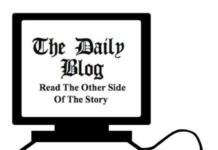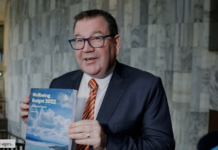Bank shareholders, speculators, investors, and ticket clippers will be partying for days over the enormous profits they’ll be expecting following Labour’s budget reveal yesterday.
After a 48 percent increase in profits in 2021, banks in particular will see another massive jump in their profits as they crank up the money printing presses to purchase the bonds the government will issue to fund its enormous $25 billion per year borrowing programme for the next three years.
Those money printing presses will also create, out of thin air, the money other investors and speculators will borrow to fund their purchase of government bonds and the Public Private Partnerships and ‘Private Sector Participation’ in infrastructure building.
More than $5 billion each year in interest payments on that government borrowing will come out of money paid by taxpayers and be funnelled straight into the pockets of bank shareholders, speculators, investors, and ticket clippers.
That tax money is being taken away from reducing child poverty, giving nurses, doctors and other health care workers the pay increases they deserve, building state houses to get thousands out of motels, sheds, and garages into decent homes, and boosting Pharmac’s budget so that Kiwis can access life saving drugs.
Instead of letting the commercial banks create that money, the government could have accessed those funds from its own bank – the Reserve Bank.
As Social Credit has been at pains to point out, Reserve Bank financing could provide the funds the government needs at no cost, without saddling Kiwis with massive additional debt and interest, freeing up tax dollars to be spent on health, education, housing and poverty reduction.
That would have provided the government with an additional $5 billion every year.
That view is supported by a report, jointly written by Treasury and the Reserve Bank, presented to Finance Minister Grant Robertson in May 2020.
The aide-memoire, titled “Quantitative Easing and Monetary Financing Compared” lays out the benefits of monetary finance compared with quantitative easing or QE (the Reserve Bank buying bonds previously purchased by the commercial banks).
The report says that Monetary Finance could be used to “meet specific funding needs of the Government at lower cost and with greater certainty than QE”.
It’s also obviously at a lower cost than borrowing ‘fairy dust’ from the commercial banks because that ‘fairy dust’ has to be paid back with interest.
Treasury and the Reserve Bank have confirmed that it’s perfectly possible for the Reserve Bank to fund the government directly saving taxpayers billions – something called for by former BERL chief economist Ganesh Nana in 2020 – “The government can borrow from the Reserve Bank. To be technical, it’s literally borrowing from itself”.
Former Finance Minister Michael Cullen (now deceased) agreed, as did Economist Shamubeel Eaqub – “I don’t see why we don’t jump straight to the RBNZ buying bonds from Treasury direct”.
Former Senior Lecturer at the School of Economics and Finance at Victoria University Dr Geoff Bertram also joined the list of those calling for different financing saying “This is not wild radicalism. It is mainstream, even conservative, economics”.
That call was been echoed by economics commentators Bernard Hickey and former Waikato University Vice-Chancellor, Bryan Gould.
Instead, Labour’s BSHIT Budget, has again thrown a few crumbs to those in poverty, those without housing, those desperately needing health care, those most needy in New Zealand, while backing the wealthy.






There must be a reason successive governments fail to use the Reserve bank in this way. It seems simple and logical. In effect we, the people, create our own finance when we need it and pay it back through government surplus when we can. Is there some sort of unacknowledged international pressure placed on our politicians is they contemplate this.
Yes there is, and of course all the advisors in Treasury and the Reserve Bank have come up through the commercial bank route. They’re unlikely to jeopardise the invitations to the fancy dinners, trips etc they get. Then of course there’s their career once they leave to think about.
Despite that Indonesia is starting to do it and China does it in spades.
And there is a tiny bit if progress. An Aide Memoir jointly written by Treasury and the Reserve Bank, was presented to Finance Minister Grant Robertson in May 2020.
The aide-memoire, titled “Quantitative Easing and Monetary Financing Compared” lays out the benefits of monetary finance (the Reserve Bank providing finance direct to the government) compared with quantitative easing or QE (the Reserve Bank buying bonds previously purchased by the commercial banks).
The report says that Monetary Finance could be used to “meet specific funding needs of the Government at lower cost and with greater certainty than QE”.https://www.socialcredit.nz/quotesfromeconomistsandexperts
The answer is in the history of nations that have attempted to do this. No one says this but Syria has it’s own state banking system along these lines and this is why they have had the last decade of chaos and why the US still sits on their oil on their hydro electricity generation , irrigation and best agricultural land. The way a society would prosper if it were allowed to operate in this way would be an example that everone would demand to follow and that would end hundreds of years of control of global wealth and power by the banking families. It will never be allowed.
D J S
We did it to fund State Housing in the past, so why shouldn’t we do it now?
Not only state housing either. The Producer Boards had access to Reserve Bank overdrafts at just 1% so producers could be paid immediately and the overdraft reduced once the product had been sold overseas.
Was that what gave rise to the SMP? ( Supplementary Minimum Price.)
If so, [it] was a con.
Producer boards guaranteed a minimum price, a price you either took of left. It was a mere stipend and once the deals were struck i.e. a SMP for wool, meat, dairy, fruit, vegetables etc the produce became the playing of the rich who literally did nothing except bank the money and the producer went home to continue working for peanuts.
Basically, SMP’s built Auckland’s leafy suburbs while keeping the producers down trodden and barely surviving. Aye Boys?
In short? Because there is no longer a “we”. “We” even let foreigners vote, for fuck’s sake.
Excellent analysis and I would like to know why this approach is not considered. Possibly because of the intense pressure from those who want to continue to pocket huge sums of money from struggling kiwis and other predictable vested interest’s.
This economy is not working for everyone and the cartels are firmly in control.
If a future left alternative is created I hope it will include Social Credit.
Its time we fought back. There is no representative party for the many who are simply serfs in this country.
One of the problems is that the extra income created passes through the trading banks, who use it as a basis for creating more money. Keynesianism seemed to become dysfunctional in the seventies, but I think that if it had not been or “factional reserve” banking we would still be using keynesian financial policies today.
economics are ideology not science and treasury/govt subscribe to an outdated ideology.